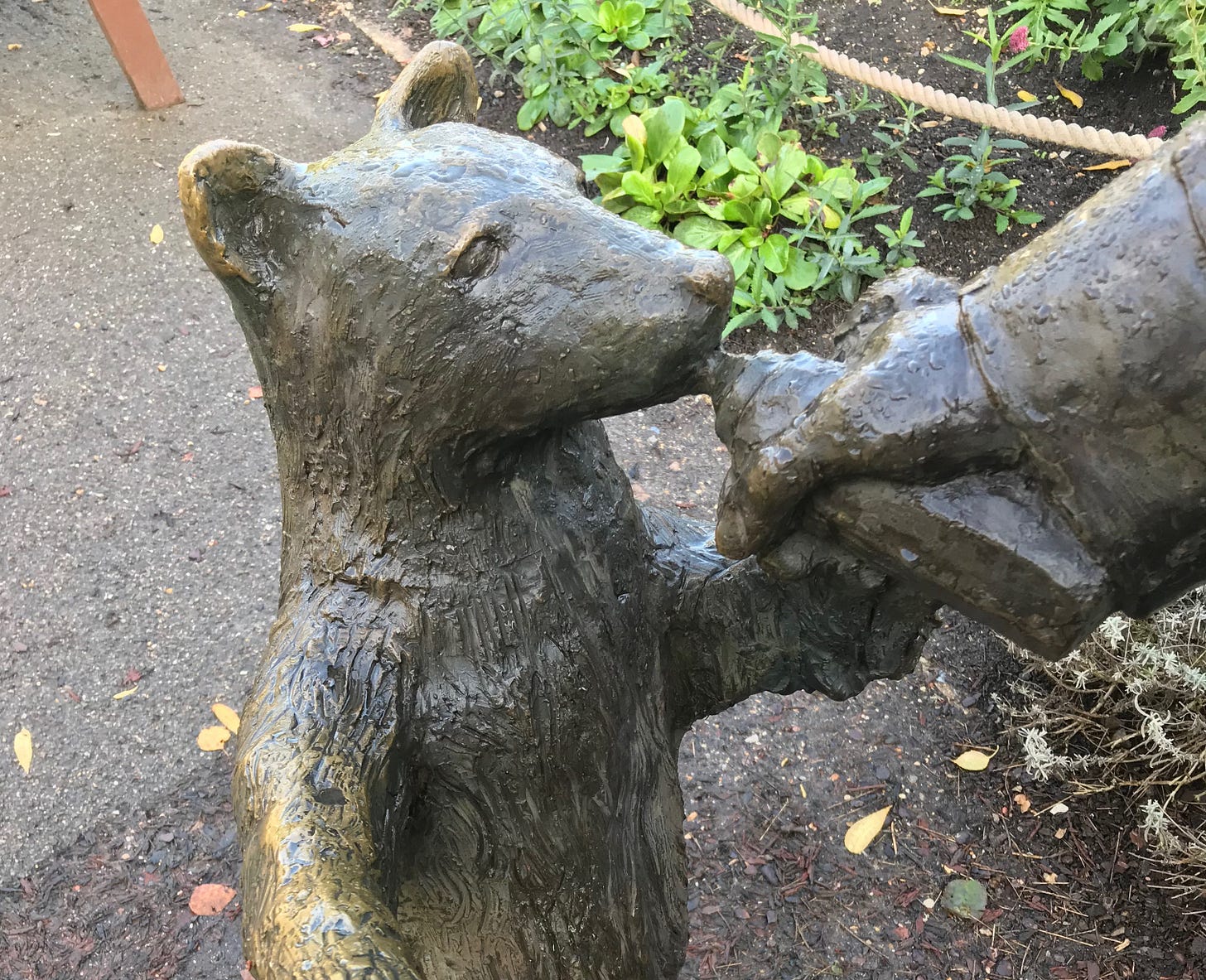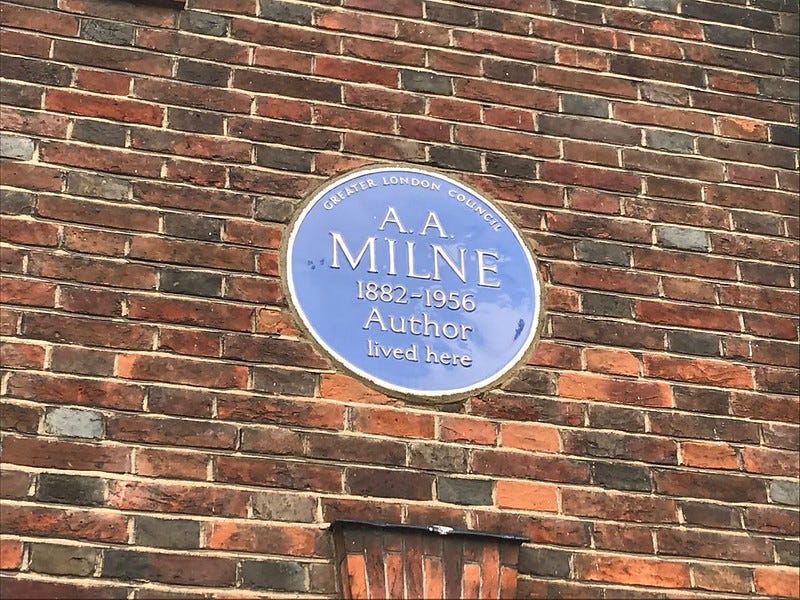Welcome to Londonist: Time Machine’s Friday newsletter for paying subscribers, with a generous teaser for everyone else.
Paddington’s grabbing all the headlines at the moment, thanks to a certain cinematic threequel. But the world’s second most-famous bear was also a Londoner. (No, not Yogi!) In today’s newsletter, I’ve been on the trail of the original Winnie the Pooh who, like Paddington, also came to London from the Americas.
That’s for the main section. First, the History Radar…
History Radar
Upcoming events of interest to London history fans.
🪦 CEMETERIES: Though we often think of London’s cemeteries as Victorian, they're actually a Georgian invention. On 3 December, The Georgian Group hosts Brent Elliott, co-author on a forthcoming book about British cemeteries, to talk about the two key phases of cemetery development, and the resulting landscapes.
🍗 FESTIVE FAYRE: Head to the first weekend of the Hampton Court Palace Festive Fayre (6-8 December) for Christmas grub in the most historical setting. Wander among the courtyards and grounds perusing artisan food stalls selling everything from Christmas pudding and brownies to chocolate, cheese, biltong, coffee, cakes — plus gallons of booze. Repeated the following weekend.
👑 MEDIEVALFEST: Though tickets to attend in person have sold out, online tickets for the British Library's ever-popular MedievalFest on 7 December are still available. Spend the day watching talks and discussions with leading historians, writers and speakers, about the medieval history of war, literature, and much more.
🍽️ GEORGIAN DINING: Also on 7 December, enjoy a "Yuletide Supper" in an historic setting with the Georgian Dining Academy. Enjoy a three-course supper (with drinks), while enjoying the history of the City and the Georgians through music, poetry and song. The rooms are candlelit, and you're encouraged to wear period costume (though it's not mandatory). 7pm-11.15pm
London’s Other Famous Bear
London has a bear population of zero. And so it has been for almost 40 years. Our last ursine residents vacated in 1985, when London Zoo shut down its bear enclosure. This brought to an end a long and grizzly history, from the medieval polar bear at the Tower of London, to bear baiting in Southwark, to the astonishing/appalling 1909 spectacle of 70 polar bears on stage at the Hippodrome. I think we can all agree that these magnificent creatures have no place in the modern city.
That’s in real life. On screen, London is once again paw-in-glove with the bear kingdom. The first two Paddington movies are works of pure joy, in which the capital plays a starring role. The second film is so adored that, by one giddy metric, it beats Citizen Kane as the top-rated movie of all time. The third film, Paddington in Peru, is less London-centric, though it does contain one marvellous, geeky London gag, which I’ll put in a footnote1 rather than spoil it for you.
Paddington is certainly having a bit of a moment. But he’s not the only internationally famous fictional bear with London links. Our city can also claim the tubby little cubby called Winnie the Pooh. He might live in the Hundred Acre Wood, but this bear has multiple metropolitan roots.
Inspired by London
Winnie the Pooh was, of course, the creation of author AA Milne. Milne was himself a Londoner born and bred. He drew his first breath in Kilburn, as marked by a green plaque on Mortimer Place. He attended Westminster School, and he lived for many years in Mallord Street, Chelsea, in a house now blessed with a blue plaque.
Milne’s inspiration for Winnie the Pooh came from two renowned London sources. The first is Harrods2. The author bought a stuffed toy bear from the department store as a gift for his son Christopher Robin. Boy and bear became inseparable, and that relationship sparked off the whole, gentle Winnie the Pooh saga.
Christopher Robin initially called his treasured bear Edward (as in Teddy Bear). But he soon had a rethink after visiting another local attraction, London Zoo. Here, Milne and son were charmed by a small brown bear named Winnie. Forever after, Christopher Robin called his toy bear Winnie, which is why you’ve never watched a Disney movie called Edward the Pooh3.
After devising bear-themed bedtime stories for his son, Milne decided to put them into print. A proto-Pooh first appeared in Punch magazine in February 1924. The character was first given his famous name in the Christmas Eve 1925 edition of London newspaper the Evening News. It proved popular, and Milne quickly worked up his tales into a short-story collection, which came out the following year. Pooh, Piglet, Tigger and co. have never been out of print since.
Winnie the who?
Where did the original Winnie come from, and whence the name? Well, like Paddington, she too was an immigrant from the Americas. The playful ursine had crossed the Pond in 1914 during the First World War, in the company of Henry Colebourn, a Canadian veterinary officer briefly stationed in London. He’d bought the cub off a hunter, and named her for his hometown of Winnipeg, Manitoba. Winnie quickly became an unofficial mascot of Colebourn’s unit The Fort Gary Horse.
There are practical limits to how far a bear can travel with an operational military unit. When Colebourn’s troop were sent off to France, Winnie was left in the care of London Zoo. This was not unusual. An Evening Mail article from 1916 notes the presence of other military mascots, including four bucks from the Warwickshire regiment, five other bears from Canadian units, and a world-weary monkey who had witnessed the Battles of Heligoland and Dogger Bank. If Disney is looking to reboot its Winnie the Pooh franchise, then might I suggest that this would be an excellent starting point.







